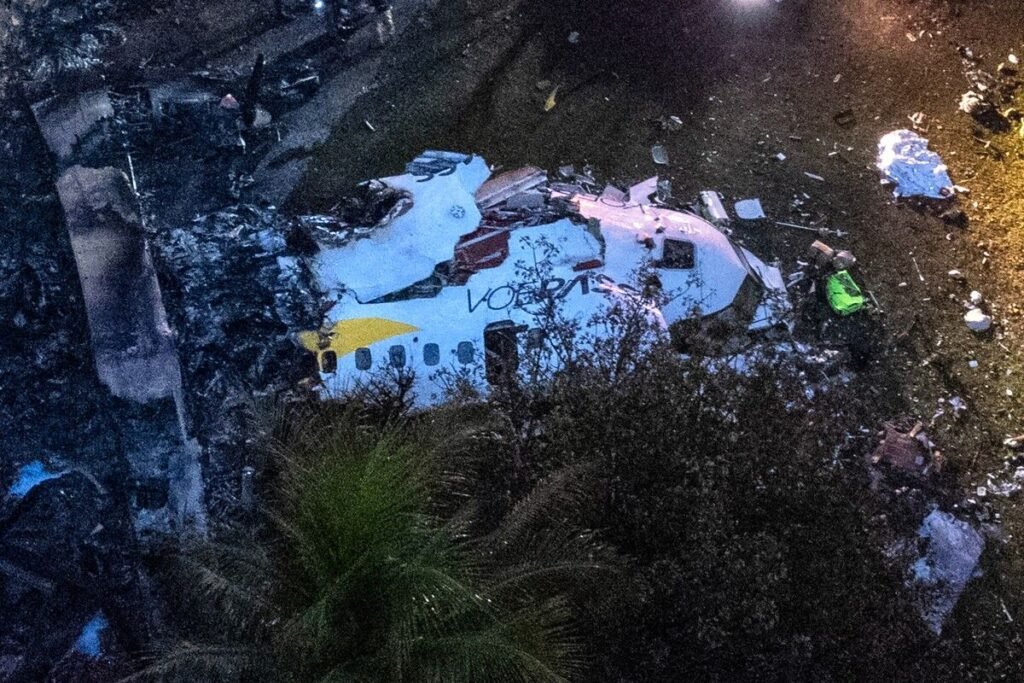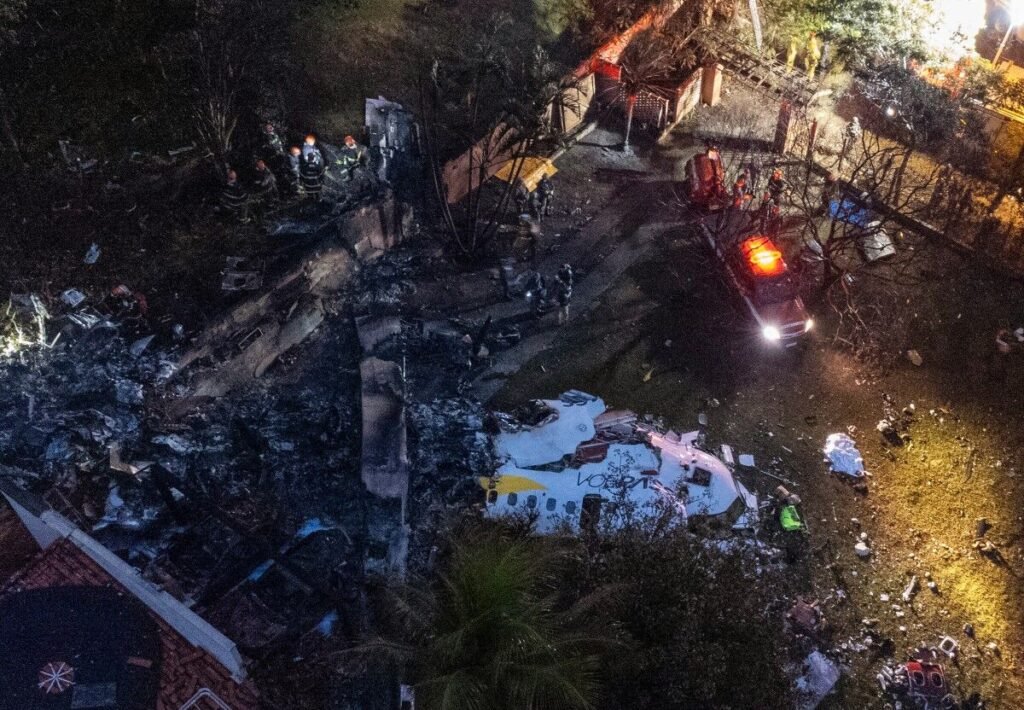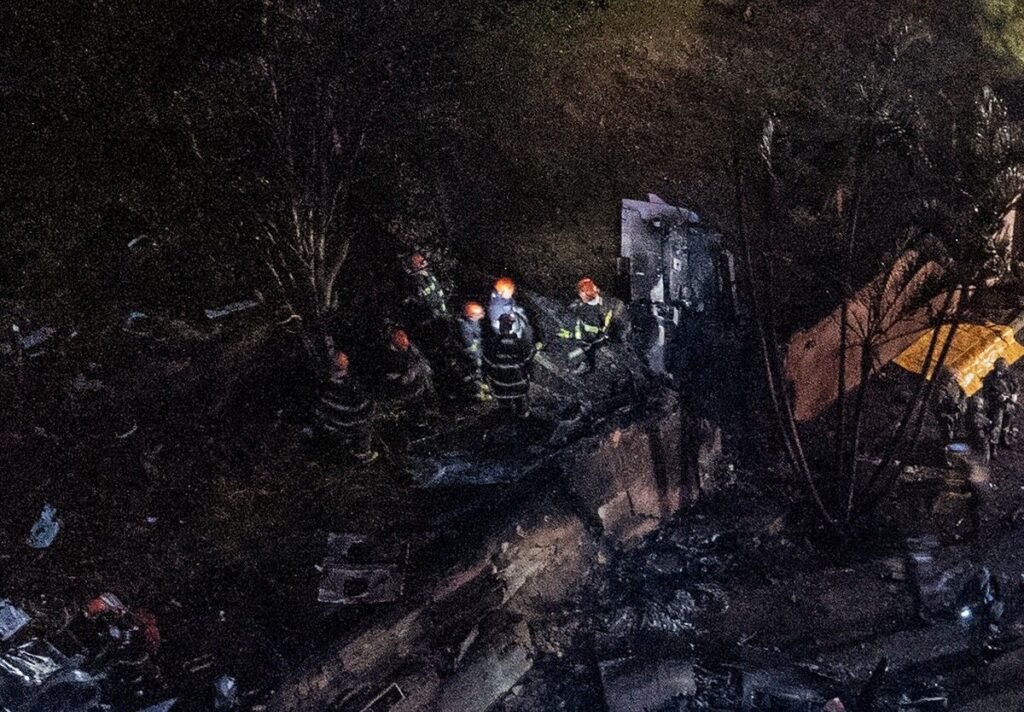Lost Above Vinhedo: The Final Moments Of VoePass 2283
- Leave a Comment
- James M
- August 10, 2024

VoePass Flight 2283, which was traveling from Cascavel to São Paulo, crashed in a residential area of Vinhedo, São Paulo state, on Friday, August 9, 2024, leaving Brazil in shock.
61 people were on board the twin-engine ATR 72-500 aircraft when it crashed: 57 passengers and 4 crew members. In addition to taking lives, the incident had a significant national impact due to the heartbreaking loss that was felt by all.
The jet plunged rapidly downward, losing control, and slammed into the ground, bursting into flames. The catastrophe happened all of a sudden. Witnesses recounted the terrifying moment the plane seemed to lose control and spiraled deadly downward.
After emergency personnel battled valiantly to contain the fire and look for any signs of life, the once-vibrant residential area was now scarred by fire and rubble. Sadly, no survivors were found, leaving grieving families and communities.
Brazil is still coming to terms with the disaster’s reality, and the extent of the loss has shocked the country. During a speech, President Luiz Inacio Lula da Silva asked for a moment of silence to remember the victims.
There is a tangible sense of loss as families wait for answers and the whole public considers the transience of life and the dangers that come with flying.
The loss of Flight 2283 has left a profound wound in the hearts of those impacted, serving as a melancholy reminder of the unpredictable nature of such disasters.
The country is still in mourning as the inquiry into what caused the tragedy gets underway. VoePass has offered support to the victims’ families and conveyed its sincere sadness over the situation.
Even though the complete cause of the catastrophe is still unknown, it will leave a lasting legacy and rank among the worst days in Brazilian aviation history.

The Final Seconds of Aircraft 2283
As planned, VoePass Flight 2283 departed from Cascavel, a city in the state of Paraná, heading to São Paulo’s international airport, one of the busiest hubs in Brazil. Designed for short regional flights, the twin-engine ATR 72-500 aircraft is a common sight on routes around the nation.
The aircraft, carrying 57 passengers and four crew members, took off without incident and cruised to its destination. But what started out as a routine trip would quickly spiral out of control and become a horrific event that nobody could have predicted.
The last leg of the flight was approaching when a terrible mishap occurred. Abruptly losing control, the aircraft plummeted at a frightening speed. Witnesses on the ground reported the terrifying scene as the plane fell out of the sky, whirling and plunging vertically.
The once-stable flying path of the airplane had become a dangerous and chaotic drop, trapping everyone within as the ground rushed for them. The last few minutes of the plane were characterized by a fruitless attempt to restore control.
The collision happened in Vinhedo, a peaceful neighborhood located distant from São Paulo’s busy downtown. The jet crashed into the earth and burst into a flaming explosion, suddenly converting the once-calm neighborhood into a scene of carnage.
The neighborhood was shocked when smoke and flames consumed the wreckage and debris was strewn all over the place.
Rescue efforts were almost impossible because so much of the aircraft was destroyed in the accident due to its extreme impact. When emergency personnel finally arrived on the scene, they were unable to save many of the people on board.
Vinhedo resident Ana Lucia saw the crash from her house. She described how scary it was to see the plane get out of control and how she thought it may crash on her own yard.
Still disturbed by the incident, she told reporters, “I thought it was going to fall in our yard.” “Thank God there were no victims among the locals, even though it was frightening.”
However, it appears that the 61 occupants of the aircraft were the true casualties. The Vinhedo neighborhood narrowly avoided the direct effects of the disaster, but not the psychological damage, according to Ana Lucia’s report.
The Vinhedo neighborhood attracted national and international attention as word of the catastrophe spread. Pictures of the flaming wreckage and testimonies from witnesses such as Ana Lucia provided a graphic depiction of the catastrophe that had occurred.
According to witnesses of Flight 2283’s final minutes, the plane’s descent serves as a chilling reminder of the risks and unpredictability of air travel.
The witnesses and the country will remember those horrifying moments for a very long time, even though the inquiry into what caused the plane to fall out of control is still underway.
BREAKING: Voepass Flight 2283, a large passenger plane, crashes in Vinhedo, Brazil pic.twitter.com/wmpJLVYbB3
— BNO News (@BNONews) August 9, 2024
The Repercussions
Fire and rescue personnel arrived at the Vinhedo scene quickly after the collision. First to arrive, firefighters battled the fierce flames that had enveloped the wreckage.
Fuelled by the plane’s fuel tanks, the fire presented a serious threat, but the firefighters never gave up trying to control it and keep it from reaching neighboring homes.
Civil defense teams and military police moved swiftly to surround the collision site with a cordon, protecting nearby residents and safeguarding it for further investigation. The sobering fact that none of the 61 persons on board survived was revealed despite their valiant efforts.
The actual crash site was a picture of complete destruction. GloboNews, a Brazilian TV network, showed aerial footage that showed the extent of the damage.
The impact and subsequent fire utterly destroyed huge portions of the fuselage, reducing the once-intact airplane to a twisted pile of metal. The residential community in the vicinity was still affected by the accident, with debris strewn all over the yards and streets.
As the fire continued to rage, black smoke billowed into the sky, providing a chilling vision of the catastrophe that had just transpired. The horrific photos from the scene served as a sharp reminder of Flight 2283’s abrupt and tragic demise.
Brazil’s President Luiz Inacio Lula da Silva spoke to the country during a scheduled engagement in southern Brazil as word of the calamity spread.
He broke the devastating news of the tragedy and declared a minute of silence in memory of the victims in a solemn moment.
The President expressed his regret in his remarks, recognizing the great loss that the families of the victims and the country as a whole had to endure.
A nationwide act of sadness, the minute of silence brought people’s thoughts to the lives lost and the pain experienced by the bereaved families. Deeply felt, the Flight 2283 tragedy left a sad stain on Brazil’s recent past.
VoePass Airlines released a statement following the tragedy expressing their sincere apologies and sadness for the event.
The airline stated that they were closely collaborating with authorities to ascertain the reason of the crash and verified that all 61 passengers had died.
Additionally, VoePass sent their sympathies to the victims’ families, providing them with support and help during this extremely trying time.
The airline provided the families of the victims with a private area at São Paulo’s Guarulhos International Airport, where the flight was scheduled to land, so they could grieve in peace and get updates on the situation.
VoePass’s reaction to the catastrophe demonstrated their understanding of the seriousness of the issue and their obligation to the victims and their families.
From offering emergency aid to collaborating with investigators to determine the cause of the catastrophe, the airline demonstrated its dedication to helping people impacted by the incident.
VoePass is still in the news while the inquiry goes on, and everyone is keeping a close eye on them to see how they handle the fallout from this disastrous incident.
Not only did Flight 2283 result in a tragic loss of life, but it also marked a turning point for the airline and the Brazilian aviation sector overall.
🇧🇷 MORE INFO FROM BRAZIL:
— DD Geopolitics (@DD_Geopolitics) August 9, 2024
Voepass Flight 2283 - Crashes in Vinhedo, Brazil, Sao Paulo State killing approximately 70 people.
Initial reports indicate that the plane was on a route between the cities of Cascavel (PR) and Guarulhos (SP). There is no initial information about the… pic.twitter.com/ZFiMsRIUM4
Initial speculations regarding the causes of the VoePass Flight 2283 crash center on a number of potential explanations. The plane may have undergone a stall, which is a situation in which the aircraft loses lift because of insufficient forward speed, according to a popular idea.
An aircraft may experience this kind of stall if its engines are unable to produce enough power or if there are problems with the aerodynamic control surfaces.
Early data and eyewitness reports indicate that the jet descended extremely quickly and uncontrollably, which is consistent with a stall scenario. But while investigators piece together the circumstances leading up to the tragedy, this is just one theory being investigated.
Former pilot and aviation specialist Arthur Rosenberg has provided insights into possible causes of the disaster, such as engine failure.
Rosenberg noted that the fast drop shown in the video of the aircraft’s last minutes could be an indication of an engine failure in either or both of the engines. A catastrophic failure to maintain altitude could arise from an engine failure that causes a loss of power and control.
Rosenberg’s analysis emphasizes how crucial it is to look through cockpit communications and engine performance data to see if an engine problem had a role in the tragedy.
The plane that crashed was an ATR 72-500, a twin-engine turboprop that is frequently employed for quick regional flights.
Although this kind of aircraft is renowned for its dependability and effectiveness on short-haul flights, it is nonetheless prone to operational problems and mechanical breakdowns just like any other aircraft. Though sturdy, the ATR 72-500’s construction necessitates careful upkeep to guarantee safe operation.
Determining if any mechanical problems or errors in maintenance contributed to the crash will require an understanding of the aircraft’s history and maintenance records.
The recovery of the aircraft’s black box, which houses the cockpit voice recorder (CVR) and flight data recorder (FDR), is crucial to the investigation.
A thorough narrative of the last minutes of the flight, complete with information on the aircraft’s speed, altitude, and engine performance as well as the pilots’ talks, can only be obtained by the use of the black box.
Reconstructing the sequence of events preceding the collision and ascertaining its cause will require this information. A preliminary examination of the black box data will provide important information on the viability of the engine failure or stall theories.
To find the primary cause of the incident, investigators will examine data from the black box and evaluate additional elements like weather, pilot behavior, and possible mechanical problems.
The airline, aircraft makers, and aviation authorities will work together to conduct a thorough inquiry. The intention is to present a thorough knowledge of the causes of the accident and to put policies in place to stop such incidents from happening in the future.

Both the relatives of the victims and the larger Brazilian society bear the scars of VoePass Flight 2283. It is painful for the families to lose their loved ones in such an abrupt and terrible way.
They are left with a great deal of emotional damage as they struggle with bereavement and the uncertainty of not fully understanding what caused the catastrophe.
Families need support systems, such as therapy and community support, to help them get through this difficult period and start the healing process.
Beyond the immediate family, friends, coworkers, and entire communities are also impacted by this tragedy as they grieve the premature passing of those on board.
The catastrophe has also made people think more broadly about the dangers of flying. The hazards that come with flying, even with improvements in safety precautions and aviation technology, serve as a sobering reminder of how fleeting life is.
This tragedy serves as a reminder of how erratic air travel can be and how easily a normal trip might become disastrous.
People are becoming more conscious of the significance of safety procedures and the ongoing need to raise aviation standards in order to safeguard crew members and passengers as they take in the news.
It is impossible to overestimate the significance of the current investigation. The investigation is a critical step in helping the relatives of the victims get closure on their numerous concerns and to understand what caused the crash.
In order for them to come to terms with their loss and achieve closure, they must understand what caused the calamity. Furthermore, the inquiry has important ramifications for the aviation sector at large.
Authorities can make adjustments and enhancements meant to stop tragedies like this one in the future by identifying the elements that led to the catastrophe.
After a disaster of this kind, calls for responsibility and openness are frequently more urgent. By carefully examining the crash, it is possible to make sure that every detail of the sequence of events is understood.
In addition to helping individuals impacted find closure, our examination upholds public confidence in the security of aviation travel. It serves as a reminder of how important it is for the aviation industry to maintain strict safety standards and constant watchfulness.
The emphasis is still on paying tribute to the victims’ memories and helping those who are left behind while Brazil and the rest of the world await the investigation’s conclusions.
Flight 2283’s tragic events serve as a sobering reminder of both the unpredictable nature of life and the ongoing need for increased awareness and advancements in aviation safety.
In order to ensure that the victims’ legacy helps to create a safer and more secure future for everybody, it is hoped that the lessons learnt from this tragedy will result in improved safety measures and a renewed commitment to averting disasters in the future.
Conclusion:
A very unfortunate chapter in Brazil’s history was closed with the fatal accident of VoePass Flight 2283, which killed all 61 people on board. The plane crashed into a residential area in Vinhedo, São Paulo state, when it spiraled out of control while traveling from Cascavel to São Paulo.
Emergency services responded quickly, however survivors were not found despite the tremendous effect and flaming aftermath.
In addition to causing the families of the victims great sorrow, this catastrophe has resonated across the country and brought attention to the danger and unpredictability of aviation travel.
It is critical that the crash’s causes be thoroughly investigated. Finding the specific causes of the accident will give the relatives of the victims important closure and aid in averting future tragedies of a similar nature.
The inquiry will look into everything, including human mistake and possible mechanical malfunctions, to guarantee a thorough comprehension of the occurrence. Maintaining public confidence in aviation and putting the required safety changes into practice depend on this examination.
Following this catastrophe, remembering the victims and providing support to their bereaved families continue to be top priorities. It is essential to give the bereaved continuous assistance as Brazil and the world community unite to mourn those who lost their lives.
In addition to making sure the families have access to care and resources during this trying time, this support also include providing emotional support.
The victims’ memories will be preserved via ongoing efforts to raise aviation safety standards and by our shared resolve to avert similar tragedies in the future.
The tragedy of VoePass Flight 2283 serves as a somber reminder of the dangers of flying and the necessity of strict safety regulations. The investigation into the crash and the efforts to bring closure to the impacted parties will occupy the next few days.
This tragedy should serve as a wake-up call for everyone involved in aviation to maintain the highest standards of safety and strive for excellence in order to protect lives. We pledge to remember the victims by striving for a safer and more secure aviation future as we consider the tragic loss.
